When I began unboxing the Scout Squad Rifle that Springfield Armory had sent me, I was happier than Wile E. Coyote with a brand new Acme catalog! I’d been waiting for weeks with building anticipation. This wasn’t going to be my first rodeo with an M-1A—I’d had two similar rifles years ago when I was in my 20s and 30s. So when this rifle arrived, it was like an old friend coming home. The intent of my article is to take a look at whether the M-1A Scout Squad measures up as a true Scout Rifle in the vision of the famous Colonel Jeff Cooper, as well as doing a straightforward review of the Scout Squad rifle itself.
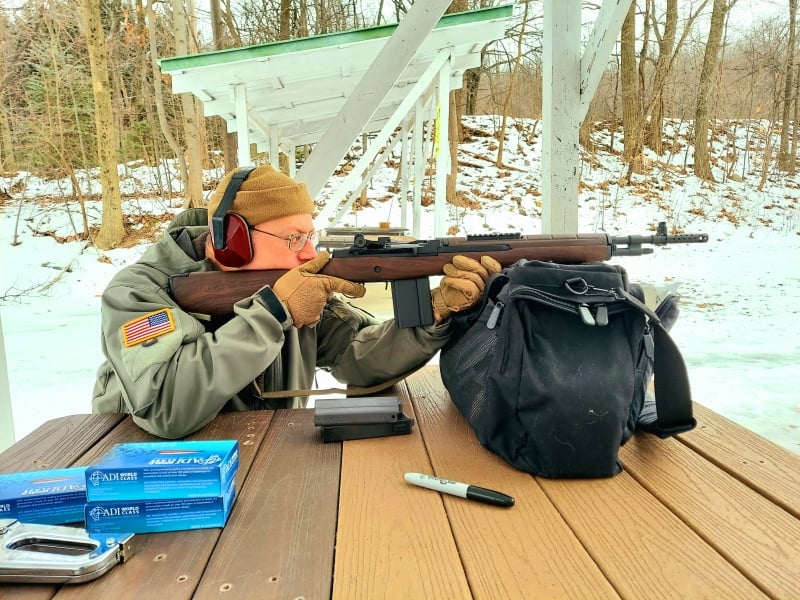
Scout Squad Rifle Predecessors
Before we dive into Colonel Cooper’s vision, let’s turn the clock back a bit to decades gone past, to the roots of the Scout Squad rifle.
M-1 Garand
Its grandfather, the M-1 Garand, was approved in 1936 by the US Army and used until around 1958. It fired the .30-06 Springfield cartridge and was fed by 8-round en-bloc clips. The Garand served impeccably during WWII and Korea, being the first general issue semi-auto battle rifle. The military, however, wanted specific improvements.
M-14
In 1958, the M-14 entered the service with those desired improvements. One huge improvement was the inclusion of a 20-round box magazine, which elevated its firepower well above that of the M-1 Garand. The M-14 was intended to replace several infantry weapons, including the M-1 Garand, the M-1 Carbine, the Browning Automatic Rifle (BAR), and the submachine gun. Unfortunately, it did not sufficiently replace all of those weapons; it could not match the BAR in automatic fire because it was not as controllable. Same with the submachine gun. As a replacement for the Garand, it did offer an improvement and was liked by the troops. Naturally, the M-14 used a shorter cartridge than the M-1 Garand (7.62x51mm vs. 7.62x63mm, respectively).
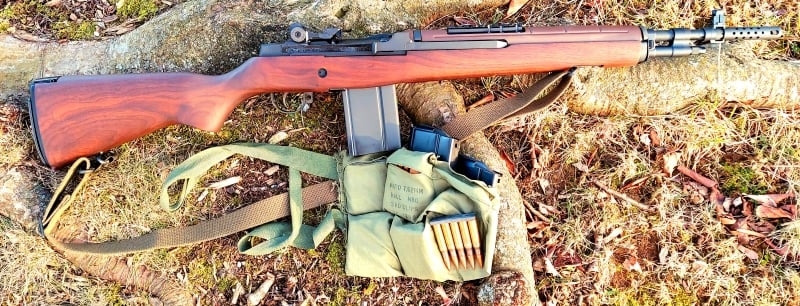
M-16
1968 arrived and saw the M-14 being replaced as the general issue military rifle by the M-16 series, which we still use today. However, that did not spell the end of the M-14, which still soldiers on in some forms to this day. Over the years, it was used by snipers as the M-21. During our wars in the Middle East, the M-14 has been used because the 7.62 NATO round offers longer range than the standard 5.56 NATO of the M-16 series. All branches of the military have used the M-14 over these years, if not as standard issue, then for certain purposes where a heavier caliber was needed or desired. It served as a Designated Marksman’s rifle in the Middle East until recently.
Scout Rifle
In the 1970s, Colonel Jeff Cooper came up with what he believed was the optimal criteria for a Scout Rifle. He perceived the need for a rifle to equip a scout, rather than an infantry team. The scout would be forward of organized elements, probably performing reconnaissance functions. Since recon’s mission is to avoid contact with the enemy, the Scout Rifle, in the Colonel’s mind, is not intended for a heavy engagement with the enemy, but rather a fast snap shot in order to break contact and get out of Dodge.
Some of Colonel Cooper’s criteria for the Scout Rifle are as follows:
- Weigh between 6.6 and 7.7 pounds (with scope and sling).
- 40 inches maximum length.
- Low-powered, Extended Eye Relief scope.
- .308 or similar caliber.
- Ghost ring backup sights.
- Accuracy of at least four inches at 200 yards.
- Barrel length of no more than 19 inches.
- Bolt action was preferred for reliability, although the Colonel said if a semi-auto could be found that was reliable enough, it would pass.
The Springfield Armory Scout Squad Rifle
The above gives us an overall picture of what the good Colonel was after as far as his vision of the Scout Rifle. Next, we’ll take a look at what the Springfield Armory Scout Squad rifle offers, and how close it comes to meeting the Colonel’s criteria (if at all).
- M-1A Scout Squad:
- 9 pounds, 3 ounces with Walnut stock. 8 pounds, 8 ounces with fiberglass stock.
- Length, 40.33 ounces.
- Rear sight, .069 aperture.
- Front sight, National Match .062 blade.
- Forward Picatinny rail.
- Two-stage National Match Trigger.
- Barrel, 18-inch, 6-groove carbon steel, 1:11.
- Muzzle Brake
When I first unboxed the Scout Squad rifle, I was a bit surprised, as it had been a good twenty or so years since I’d held an M-1A. I found that it had gotten a bit heavier than when I’d held one when I was in my 30s. Well, not really…I was just in better shape back then, and now things just seem a bit heavier. That said, I’m not sure I’d want to lug a heavy rifle around for miles in the bush these days.
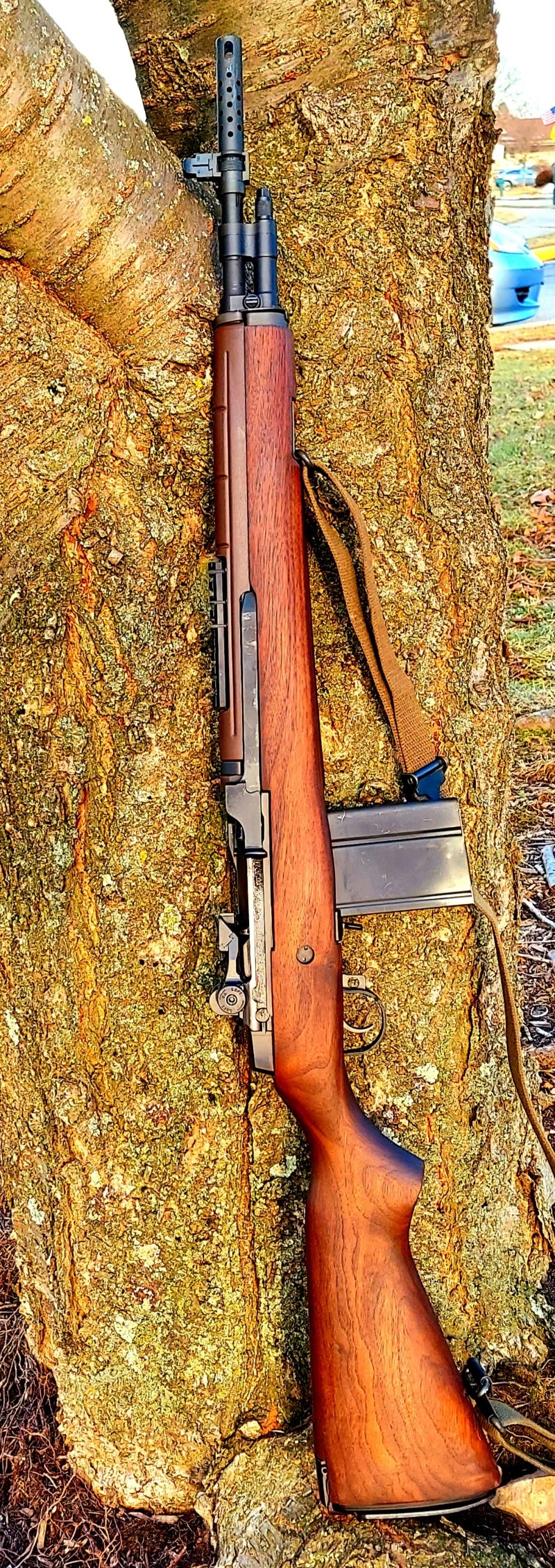
Fast forward several weeks. Now that I’ve had plenty of opportunities to handle and fondle this piece of artwork, the weight of the rifle seems more “normal” now. And because of the fact that it’s shorter than a standard M-1A, it handles very well. Aside from that, the M-1A is just as beautiful as I remember. Since it’s made from steel and wood, it has that Old World charm and soul that classic weapons seem to have. I’ve always loved the Garand action, and the M-1A’s action is extremely similar, which is a huge plus in my opinion. Aside from it being a classic, the action just works damn well, as it has for decades. It’s a timeless design that just functions and is forgiving as far as recoil is concerned.
Since I’m on a tangent about nostalgia, that’s the reason why I chose the Walnut stock. It looks very classic and is simply high quality and beautiful. Aside from aesthetics, it is built like a tank—incredibly robust. You will not find a rifle stock like this on any of the plastic rifles these days. Yes, plastic rifles do offer quite a bit of performance, but as I mentioned earlier, they are cold and have no soul. No, I’m not bashing AR-15s and Glocks, I have both and love them for what they are. But dammit, the M-1A is just a Picasso! Don’t believe me? Pick one up. Rack the bolt and listen to that wonderful sound. And seriously, the walnut that they used for the stock has such an attractive grain, it’s unreal.
Does it meet Scout Rifle specs?
No, it does not meet the Colonel’s criteria. So, what’s the point? Is all lost? I think not. Let’s examine what we have here, and see if the Scout Squad Rifle still has a place in our toolbox. First, does anyone need a rifle such as this?
I believe it would serve rural law enforcement officers very well, given its relatively short length and powerful cartridge. An officer who has to wait a long time for backup could benefit from a rifle in a major caliber, especially in a rural setting. Aside from facing potentially dangerous four-legged animals, they might face poachers who are armed with hunting caliber rifles. In these instances, having a semi-automatic rifle with a substantial capacity in a major caliber could very well spell the difference between surviving or not. What comes to my mind here is a sheriff working so far out in the middle of nowhere that sunshine has to be piped in. If I were in that position, having a .30 caliber rifle with a 20-round capacity would be a profound comfort.
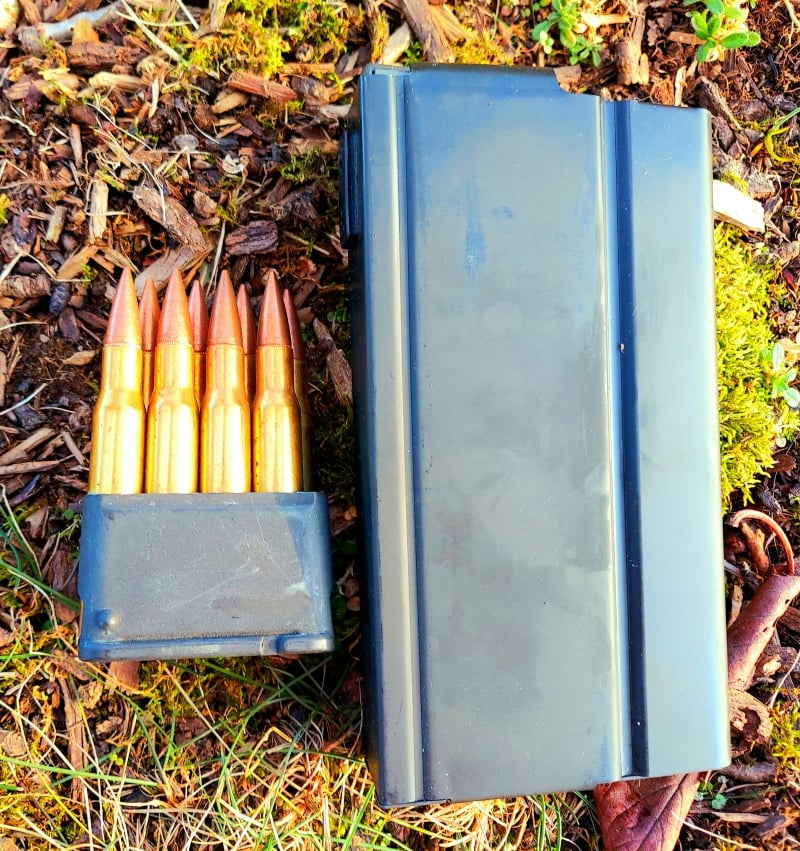
Folks who live in rural locales will also be attracted to the full-sized caliber, as it gives stopping power against dangerous animals such as bears or mountain lions. The added range that the .308 offers is a plus in such environments. Ranchers and farmers come to mind here.
As well, anyone who might need to stop vehicles will also appreciate the .308’s added punch and penetration, which appeals to military and law enforcement.
When I was in law enforcement, my coworkers and I kept a lot of gang members locked up in prison for a long time. I received my share of death threats over the years from some of the very worst people on the planet from almost every gang you’ve ever heard of and quite a few that you probably haven’t. That is always in the back of my mind, and I conduct myself accordingly. Should a van full of gang members roll up at my residence looking for revenge, that Scout Squad rifle will go a long way in balancing the odds, as will the obscene amount of time that I’ve spent training.
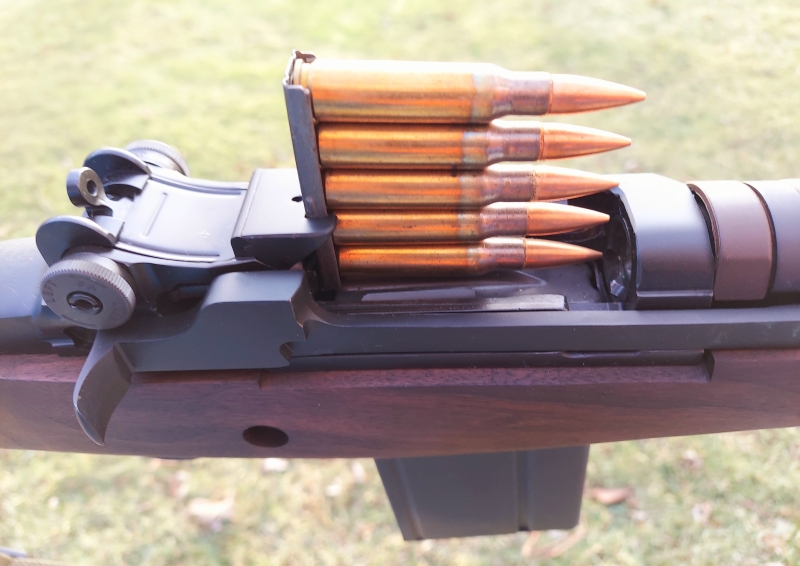
This brings me to a point about Cooper’s proclivity toward the bolt action; that mode of operation does not facilitate rapid follow-up shots for obvious reasons. For social purposes, we want and need an autoloader. It would be foolhardy, at best, to face multiple threats at close range with a bolt action if we have other options. If threats are over a hundred yards away, I’m comfortable with a bolt gun, but in close, the semi rules the roost.
Is it an antique?
I’ve heard some people say that the M-14/M-1A platform is “antiquated” and should have been retired long ago. Personally, I think that line of thinking is drastically flawed, as the rifle is no less effective now than it was in the 1950s (and the M-1 since the 1930s).
Let’s put it this way…if you are, perhaps, a police officer and a fugitive has taken refuge in an area. It’s your job to go in and root him out, and he’s armed with an M-1 Garand or M-1A. Would you be at ease going in there to take him on?
I wouldn’t. Because those “antiquated” rifles will kill you just as dead now as they would have the day they came off the assembly line in the 1950s or before.
And let’s not forget, Eugene Stoner’s AR10/M16 series of rifles were also designed back in the 1950s, so they are just as “antiquated” in design as our M-1 series.
Let’s take a look at the Scout Squad Rifle features.
Controls
The M16 series has controls that are probably the best in the world, granted. The location of the selector switch and magazine release is just about as perfect as we’re likely to ever see, which is a boon for that series.
So how about the controls of the M-1A? While not optimal, they do work well. Much hysteria has been verbalized about the location of the safety on the M-1/M-1A, specifically about having to have one’s finger inside the trigger guard. It is what it is—the safety has worked since the beginning, and one simply has to be cautious when using it. But then, doesn’t that apply to any safety for any firearm we’re using?
The magazine release and rocking method by which the magazine is inserted are similar to the AK series and can take some getting used to. If the shooter does not line up the mag correctly for insertion, it’s easy to fumble a mag change.
As for the charging handle of the M-1A, it isn’t bad. Again, it’s similar in location to the AK series, along with many other semi-autos that are out there. Certainly, it’s not a hindrance and works as well as any others.
Sights
Now we come to one of the best features of all…the sights! The M-1/M-1A series has the very best iron sights, in my opinion, of any rifle out there.
The rear aperture (or “peep” sights, as many of us old-timers refer to them) is incredibly efficient, with the eye naturally centering the front sight post in that circle. It just works like magic. In fact, the iron sights of the M-16 family have copied not only the rear aperture but also the front sight post and ears, of the M-14 series. They are easily adjustable for windage and elevation via positive clicks and are relatively durable, which makes them a pleasure to use.
Clearly, people like this sight system and have paid attention, because it has carried to the present day from the mid-1930s. That is a testament in and of itself! Springfield thought ahead and opted for the National Match front blade, which is a bit thinner than the standard. The reason that this is a wise move is because of the shorter barrel (18 inches on the Scout Squad versus 22 inches on the standard M-1A), which brings the sights closer to the eye. That would make the front blade appear thicker if they used a standard thickness blade. As it is, that thinner front blade will not appear to be so thick, which will help accuracy at distance.


Furniture
These days, everything seems to have a pistol grip (and even some chassis for the M-1A can be had with a pistol grip). People equate the pistol grip as a modern necessity in current times. The truth, though, is that the classic-style buttstock is still eminently functional and can be very efficient for slicing the pie around corners, even more so than a pistol grip-equipped rifle. Despite this, there are a few chassis out there that are equipped with pistol grips for the M-1A if the user desires.
No, this isn’t a SCAR. It isn’t the latest, greatest, most new-fangled piece of plastic wonder gear. For the tacticool crowd who has to have the newest piece of fashion gear, the venerable M-1A will not likely float any boats. And you know what? That’s perfectly okay. I chuckle to myself sometimes when I look at the latest gun rages these days, as they’ve become more of a tactical fashion show than something practical.
The Weight
Where the M-1A takes some lumps is in the weight department, and there’s just no way around this one. It’s relatively heavy at 9 pounds, 3 ounces (with composite stock, it’s 8 pounds, 8 ounces). That might become an issue for some if they’re humping this rifle over hill and dale for mile after mile.
On the flip side, I saw one former Marine who served in Vietnam state, “I didn’t know that the M-14 was too heavy until I rotated back to the states and read that it was too heavy. I carried it for my entire tour never realizing that it was too heavy for me to carry.” So there’s that.
Bear in mind that the weight will be an asset as far as recoil is concerned, with the rifle soaking up the recoil nicely. Another thing that helps with the recoil is the excellent gas system and the recoil spring.
While we’re talking about weight, the M-1A does not weigh much more (if any more) than other comparable .308 caliber rifles. The SCAR-17 comes in around eight pounds. So if we’re talking about the composite stock on the M-1A, it comes within a few ounces of the SCAR-17.
Caliber
As mentioned, the .308 Winchester (7.62×52 NATO) is a serious caliber, with the popular bullet weight being in the 150-grain range, traveling around 2,750 feet per second. I like how Colonel Cooper described it: “When you shoot something with it, it stays shot.” When training with 5.56 weapons, we’re taught that we likely will have to fire a few shots to put an attacker down. With the 7.62, there’s less chance of needing multiple hits, considering that the projectile weighs close to three times the weight of a 5.56 round and puts a .30 caliber hole in the target. Bigger holes naturally cause more blood loss.
Springfield Armory emphasizes that military surplus ammunition should be used with the M-1A series due to the floating firing pin and the possibility of slam fires. Soft primers might be vulnerable to this phenomenon.
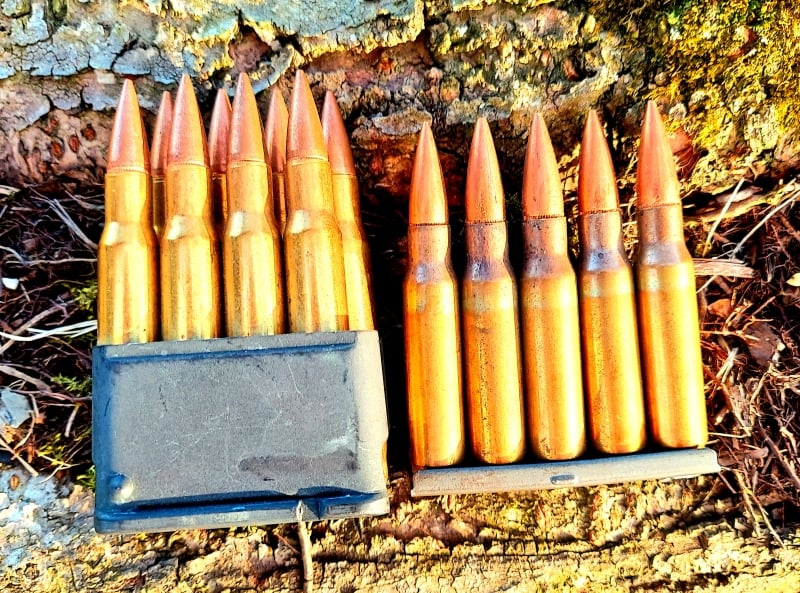
Capacity
As mentioned, the M-1A is fed from box magazines. I’ve seen them in 5, 10, 15, 20, and 25-round capacity. Many military surplus magazines are floating around out there, in addition to newer production magazines. I like the ones from Springfield Armory, personally, as they are very well put together and clean.
One major asset with M-1A mags is their durability; nice, heavy metal that is not likely to break very easily if dropped onto the ground. The 10-rounders are nice for prone shooting or shooting off the bench, as they don’t extend below the rifle very far. Personally, the 20-rounders are my favorites, though.
The rifle also has a stripper clip guide just in front of the rear sight base so that magazines can be left in place of the shooter desires and fed via stripper clips. I’m not sure I’d like to feed the rifle in that manner during combat, but it’s a neat option for when the stress is not as intense.
Legalities
The M-1A truly shines in communities that are oppressively restrictive in their gun laws. It just looks less “threatening” to the sheeple who feel vulnerable and phobic toward inanimate objects. The wood stock helps it to look more traditional. The fact that it does not have an evil pistol grip and flash suppressor also helps. Many anti-gun laws prohibit those features, so it helps that the rifle’s original configuration does not have them. The muzzle brake looks very much like a flash suppressor, but it technically is not (although it does do a splendid job in reducing muzzle rise).
So the only “evil” feature that the M-1A does have is the fact that it can accept standard capacity magazines. For the time being that gets us around most of the draconian laws that infringe on our amendment that states, “…shall not be infringed.” It’s nice that people living in such areas can actually possess a rifle that helps them to be able to defend themselves.
Handling the Scout Squad Rifle
Since the Scout Squad is about four inches shorter than a standard M-1A, it is inevitably going to be a bit handier, and I can verify that this is the case. If there was a way to convey it in print, I would, but doing so is exceedingly difficult. That said, with the barrel being four inches shorter, the rifle swings faster and indexes much more quickly than a full-sized rifle. And it’s not just a perception that it indexes more quickly, it actually does.
If you need to go around a corner, the stock can be pulled far back, bringing the muzzle closer to the user so that he is not telegraphing around a corner. That’s one advantage over having a pistol grip; that straight stock can be more flexible in this realm.
The rifle has a solid feel; frankly, it feels like a tank. But in a good way! When you hold this rifle, it lets you know that you’re holding an honest-to-God real rifle that is built for business and will get the job done.
My main complaint about the handling is that it’s easy to fumble a magazine change. The way that the magazines have to be inserted and rocked into the magazine well has to be somewhat precise. It’s far from impossible but just takes some practice and repetition to perform reliably. It’s similar to a magazine change on an AK-47. The magazine release works well enough, though it does take a bit more effort to use than, say, the AR-15/M-14 series. Is it a deal-breaker for me? No.
At The Range
As mentioned, the muzzle brake works like a charm; the recoil was modest, to say the least. It was there, of course, but it was more of a gentle shove. Nothing sharp about it at all, and not much muzzle rise. I went through some drills to see how fast I could land a follow-up shot on targets, and it was very quick.

Before those drills, though, I needed to zero the rifle. I fired it at 50 yards initially, but it wasn’t even hitting paper. Apparently, at the factory, they test-fired it using a scope, so the iron sights were not zeroed. In short order, I had the rifle zeroed, and the knobs on the iron sights made that extremely easy to do.
The targets from the factory showed pretty tight groups. As mentioned, they used a scope for that. On this particular day, I wasn’t expecting to come close to the factory groups in my wildest dreams, given the wind that was blasting me in the face and screwing with my eyesight.
It was at that point that the surprise of the day made its appearance. I somehow managed to turn in some groups that I had no business shooting. The best was 1 ¼ inch using ADI 168 grain HPBT Match. The next best group was 1 ½ inch using Aguila 150 grain FMJ. The reason I’m blabbering about these groups is that my eyes really aren’t that great anymore, and combined with the environmental conditions, the fact that my eyes were watering because of the wind, I was expecting groups to be more in the 4-5 inch range. This rifle can shoot!
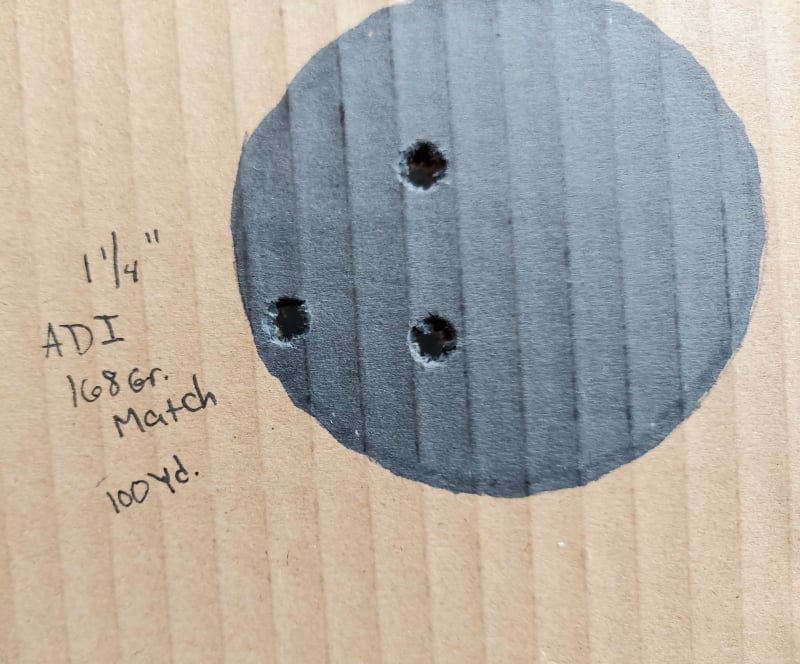
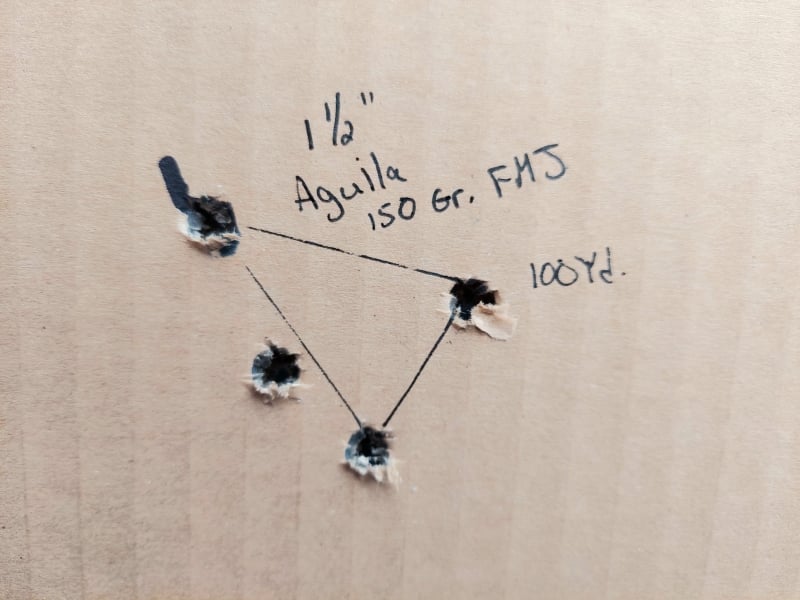
Beyond that, the rifle is a smooth shooter. The Garand-designed bolt is oh-so-satisfying when firing. It feels different from most other semi-auto rifles, in that you can feel the bolt smoothly clanging in the action. For lack of a better term, it just feels neat!
Naturally, reliability was 100% perfect, and I expected nothing less. All in all, not bad for a technology that was born in the 1930s and still going strong today.
Overall, this is an excellent platform. No, it’s not an ultra-modern, plastic ray gun. This is a rifle made during a classic era. Not to sound cliché, but it’s a man’s rifle, strong and robust. This is the last “Battle Rifle” that the US adopted (battle rifles being in a major caliber such as 7.62 NATO as opposed to assault rifle calibers in 5.56 NATO).
The rifle ships from Springfield Armory with one magazine, a 10-rounder. 20-round magazines are available from Springfield Armory for a little over $50 each, so that’s a consideration. One thing about Springfield magazines—they are incredibly well built. We’re talking utterly tank-like. They put most other magazines to shame and will last for decades. I know people who are still using military surplus magazines from the 1960s (yeah, they’re that tough). I have to say that I’d like to see the rifles come standard with at least one 20-round magazine in areas where they are legal.
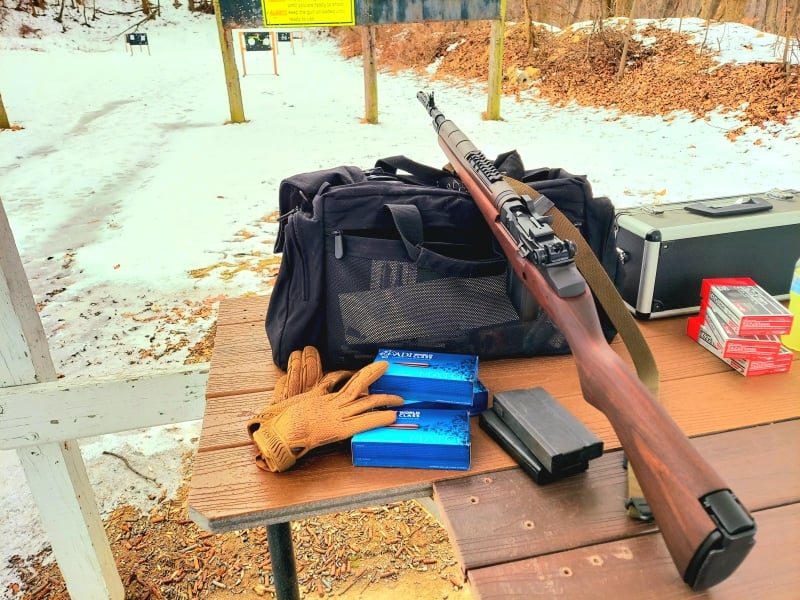
So how does the Springfield Armory Scout Squad Rifle stack up?
Overall, it passes with flying colors. I’d choose it every day of the week, and twice on Sundays. The accuracy is very good and the sights make it easy to be very accurate, even with the aging eyes of a slightly past-middle-age guy.
Reliability is spectacular. Yes, it’s heavier than Colonel Cooper envisioned for his Scout Rifle concept. Suffice to say, the Scout Squad is not in the same realm as the Colonel’s Scout Rifle, and I can live with that. It handles superbly even if it’s heavier than a traditional Scout Rifle. It has what the Scout Rifle doesn’t, which is capacity and firepower. And it looks awesome doing it while being a beautiful piece of history. I’d carry this rifle into combat if I had to, it’s that good.


